#babylonian tiles
Explore tagged Tumblr posts
Text

B-Side Magazine December 94/January 95/ Spectral Evidence column
Featuring:
Ordo Equitum Solis
Faith and the Muse
Love Spirals Downwards
Kommunity FK
Children on Stun
Daucus Karota
Black Tape for a Blue Girl
Babylonian Tiles
National Razor
if you like my scans and want to repost them off of tumblr or crop/otherwise make edits to any of the photos contained within this article please credit my blog and the original photographer (where applicable), and if you’re feeling extra generous and want to help me out you can donate via my ko-fi donating will allow me to obtain more magazines to scan and upgrade my equipment
#ordo equitum solis#faith and the muse#love spirals downwards#kommunity fk#children on stun#daucus karota#black tape for a blue girl#babylonian tiles#national razor#enjoy goths 💋#b-side magazine#90s#magazine scans#my scans
10 notes
·
View notes
Text
#TwoForTuesday + #TilesOnTuesday:
2 of 120 lifesize #lions that lined the Processional Way from the Ishtar Gate to the Temple of Marduk at Babylon.


Striding Lion Panels
Mesopotamian, Babylonian Neo-Babylonian Period, reign of Nebuchadnezzar II 604–561 BCE
Findspot: Iraq, Babylon, 1899, excavated by the Deutsche Orient-Gesellschaft for the Kaiser Friedrich Museum, Berlin
Terracotta glazed bricks
1. Museum of Fine Arts, Boston 106 x 232 cm
2. RISD Museum 104.1 x 228.6 cm
#animals in art#museum visit#lion#lions#Babylonian art#Mesopotamian art#ancient art#mosaic#tilework#pair#Striding Lion#RISD Museum#Museum of Fine Arts Boston#Two for Tuesday#Tiles on Tuesday
23 notes
·
View notes
Text
Mario & Sonic Party part 3
(Part 1) (Part 2)
Okay, now we're doing Minigame Mode
So the framing device for the Minigame Mode menu as a whole as well as the Free Play menu is that Peach's Castle ended up in Spagonia and the Submode Selection and Minigame Selection uses magic portal paintings like in Super Mario 64, with Toadsworth and Professor Pickle curating the gallery. If a submode or minigame is still locked, the painting will be obscured by abstract blobs of color.
Fishing Battle
That one mode in nearly every Mario Party where you pick a minigame category (4-Player, 2-vs-2 and 1-vs-3) and whether you need 3, 5, or 7 victories to win. In this case, it's represented by the Players' characters fishing with Big and a Lakitu, and when you win a minigame you catch a fish.
Duel Simulator
Professor E. Gadd and Eggman Nega's laboratories got fused together in such a way that the doors are missing, and they've decided to make the most of it and simulate the playable characters going head-to-head in Duel Minigame Tournaments. We've got the two duels in round 1, then the 3rd-4th playoff, then the final round, as you'd expect. The Players can decide who squares off with who in the first round.
Extreme Racing
The single player Minigame Endurance mode. The Player must compete in 100 consecutive Minigames of any type (except Item and Boss Minigames) and can only lose 3 times before getting a game over. The host duo and racecourse aesthetic are different depending on the difficulty level. On Easy, you race against Storm and the Spooky Speedster through ancient ruins, with elaborate depictions of both Ancient Babylonians and Thwomps carved into the walls. On Normal, you race against Wave and Koopa the Quick through a tunnel that appears to be part of an Eggman base, with a window on one side that reveals the tunnel is hanging over a lava lake near one of Bowser's Castles. On Hard, you race against Jet and Il Piantissimo on a path made of clouds and vines high in the sky, with Sky Babylon visible in the distance. On Master, you race against Metal Sonic 3.0 and a Cosmic Mario on a mechanical version of Rainbow Road, with both the Comet Observatory and a not-blown-up Death Egg visible in the distance. On Super, you're on a comically long wooden pier being chased by the Sonic Adventure Orca. It gives up and swims away at the halfway point, only to immediately be replaced by a giant Cheep-Cheep.
Tile Trial
It's basically just MP5's Mini-Game Wars with a bigger grid, because it's my favorite of the Colored Tile Minigame Submodes. Sticks and Orbulon are the Hosts because I think they'd play off each other well, and there's now a 2-vs-2 version called "Badgers Versus Aliens."
Chaothlon
The usual Minigame Decathlon framed as a Chao Race. It's hosted by Toad and Omochao, and every character uses a Chao that looks like them...with a few exceptions.
Cream obviously uses Cheese.
Ashley's Chao is clearly just Red under the effect of a transformation spell of some sort.
Petey Piranha uses a Nipper Plant
Bowser Jr. uses a Hero Chao wearing a Bandana identical to his.
Metal Sonic and Omega both use modified Omochao Because Robots.
Boss Rush
Kamek and Sage challenge 1 or 2 players to play every Boss Minigame back-to-back. The order is random, with the exception of Dimensional Collision Zone's boss, which is always last. This is the only way for Blaze, Ashley, Junior and Metal to fight the bosses, and it's probably a bit awkward for Junior and Metal because they are the boss fight for BowsEgg Battle Cruiser.
That's it for Minigame Mode, but this post ain't over yet!
Bonus Mode
The Dream World and Maginaryworld got fused just like everything else, but because they're both just Dreams it isn't that big a deal. So, Prince Dreambert and Illumina collaborated on three special dreams that house Bonus Games for the playable characters to enjoy.
MicroDream Mayhem
A single player bonus game hosted by Lumina. It's literally a WarioWare stage with "Mario + Sonic" as the theme. There's about 30 mirogames (which I will not be coming up with. nor will I be coming up with the Minigames. That Way Lies Madness.)
Dream Ralley
Four players race through a platforming course created by Dreambert, because of course you'd put platforming challenges into a crossover between two of the most famous platformer series of all time. Each difficulty level has three courses to choose from (Dreambert has a lot of free time).
Nightmare Shuffle
Void has created a few small, simple boards that use the mechanics of Sonic Shuffle instead of Mario Party. I bet you thought I forgot about Sonic Shuffle, didn't you?
Extras Mode
Hosted by Starlow and Shahra, this Mode houses the Star Bank and has some extra content that didn't quite fit in the other modes. Namely:
Unlockable figurines like the ones in MPDS.
3 special single-player Minigames.
Unlockable artwork of the characters, usually involving the various counterparts interacting.
The soundtrack, available for your perusal and listening pleasure.
Options Mode
Exactly what you expect. Hosted by a Goomba and an Egg Pawn.
#mario party#crossover#sonic the hedgehog#toadsworth#professor pickle#big the cat#lakitu#professor e gadd#eggman nega#babylon rogues#storm the albatross#spooky speedster#wave the swallow#koopa the quick#jet the hawk#il piantissimo#metal sonic 3.0#cosmic mario#sonic adventure orca#cheep cheep#sticks the badger#orbulon#toad mario#omochao#chao#chao race#nipper plant#prince dreambert#illumina sonic shuffle#lumina flowlight
6 notes
·
View notes
Photo

https://www.tumblr.com/persian-esque
CASCOLY - BABYLONIAN ARCHERS, ASSYRIAN MOSAIC TILES
9 notes
·
View notes
Text


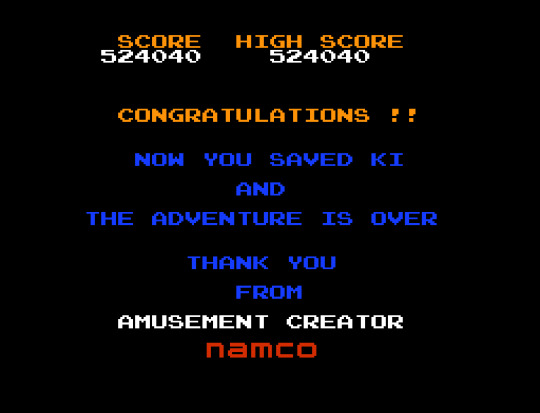
[Hi! For... god, years now, I've had this massive Spreadsheet (yes, it requires a capital letter) of retro JRPGs I've wanted to (1) play my way through and (2) blog about. (1) was fairly easy after I stopped trying to play on original hardware, but I found it surprisingly hard to do (2) without it devouring all my free time. So instead of a dedicated blog, I'm just gonna do these short summary posts here whenever I beat a game. There's two in the backlog right now, starting with...]
What it is: The Tower of Druaga (ドルアーガの塔 Druaga no Tō) for Famicom, released on the 6th of August, 1985, developed and published by Namco. Based on the arcade game of the same name from June 1984, also published by Namco and chiefly designed by Masanobu Endō, creator of early scrolling shmup Xevious, it's the first game in - the Spreadsheet as a whole, yes, but also the Babylonian Castle Saga, a collection of (for the most part) vaguely RPG-like action games that tell the story of a prince named Gil, his lover, the priestess Ki, and their quest to restore peace to their loosely-Babylonian fantasy world.
What it's about:
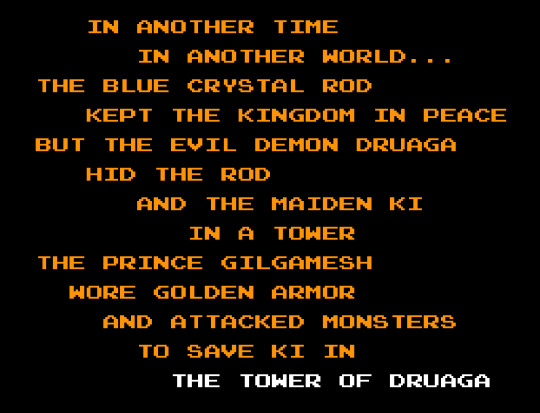
I think the attract screen puts it pretty well! There's some more wrinkles to the backstory, which I mostly got from a strategy guide released at the time - an invading empire, the goddess Ishtar, the precise mechanics behind why, exactly, this is our heroes' last chance to save their kingdom - quite a lot for a mid-80s arcade game. It's pretty thin by RPG standards, but as a setup, it works, and I found it surprisingly engrossing.
How it plays: How do you make an RPG work in the arcade? Apparently, you turn it into a Pac-Man clone. Okay, that's a little flippant; Druaga may be a maze chase game, but there's a lot more going on in it than in most arcade games of its day. On the surface, it's a game about running around mazes, killing monsters, and grabbing keys to get to the next floor, until you defeat Druaga and rescue Ki on the top of the tower. All you have to do is fight your way to the sixtieth floor, right?
In any other arcade game of its era, maybe, but not here. Almost every floor of the tower also contains a hidden treasure that can only be revealed by performing a specific action unique to that floor. The higher Gil gets up the tower, the more he'll need them, from books to reveal the layout of darkened floors to a series of items that turn the increasingly common dragons from the most dangerous enemies in the game to an easily ignored afterthought. Pretty much every useful item in the game (there's several duds and a few traps) is needed to defeat Druaga, so knowing where they are and how to reveal them is absolutely key to beating the game.
The catch - because of course there's a catch - is that neither the treasures' locations nor their revealing methods are signposted at all. Every single one has to be trial-and-error brute-forced out, and they can get pretty arcane - entering a fairly long cheat code, defeating several enemies in a specific order, walking over a particular tile in a particular direction... The intent was for arcade-goers to 'solve' the game together, figuring out all its secrets over the course of weeks or months, but when you don't have a friendly mid-80s Japanese arcade crowd to help you out all you're left with is a mountain of guesswork. Or a walkthrough, which has been a standard bonus feature on its Namco Museum rereleases since the mid-90s.
What I thought: I had a lot of fun with this game! Admittedly I was using a walkthrough (in Japanese, because part of the purpose of the Spreadsheet is to practice my language skills) to bypass about half of the Intended Experience™, but the other half, the straightforward arcade action Pac-Man-with-a-sword gameplay loop, was engaging enough in its own right. Gil controls really well, you never feel like you're fighting the programming instead of the monsters, you can always tell why you died even if the game took a cheap shot, and its insanely generous continue system lets you jump right back to the level you were on with all your items intact when you run out of lives. It's still tough, but it's tough in a fair way, breaking up its fast-paced action into discrete digestible chunks with a chance to breathe between every floor. And frankly, though it is 1980s quarter-muncher hard, I've played indie puzzle platformers that were much worse.
And I do think it succeeds at distilling the RPG into an arcade format, though the result is only an RPG by the loosest possible definition. Despite the lack of numbers and exploration (well, in a sense) there's a distinct feeling of progression to Gil's journey up the tower, a kind of character growth uncommon to - basically any genre outside the RPG in 1984. As Gil collects treasures, he grows faster, stronger, better at navigating the labyrinths, to the point that, despite the increasingly tougher challenges the game throws at you, it almost gets easier the further along you get. With the continue system I mentioned, you can even jump back to floors you've already cleared (mostly to replace a particular item that occasionally breaks) and breeze through the monsters that once gave you so much trouble. It's this kind of thoughtful design that makes me really appreciate Druaga, more than I honestly expected to when I first booted it up. Give it a try, it's pretty good!
#tales from the retro jrpg Spreadsheet#babylonian castle saga#the tower of druaga#famicom#1985#namco#retro rpg#true story: in the time between starting this post and finishing it i have beaten a third rpg#it's the original zelda. fuck you that's an rpg#but yeah by the standards of modern games druaga (with a walkthrough) is... moderately hard but not severely so#you ever play cuphead? it ain't as hard as cuphead#we'll next see gil and ki in the quest of ki (1987)#but the next game on the Spreadsheet comes out in december 1985#called bokosuka wars. see you then!
4 notes
·
View notes
Text

“The plasticity of clay and its enduring hardness after firing led to its appreciation by early man. The Babylonian vase, from Kish, is about 4000 years old. Archaeologists find, in fired clay, the chief indestructible material through which they can trace the history of ancient civilizations. Five thousand years ago, Egyptian clay workers manufactured bricks and pipes, jars and bowls and other products for daily use. Except for improvements in the mass production of clay forms, the basic nature of clay manufacturing has changed very little. In modern times, clay is used to make pottery, bricks, tiles, dinnerware, sculpture, firebrick and sanitary fixtures. It is also used in the manufacture of face powder, paints, paper, linoleum and rubber products. Clay touches the lives of all. One of the happiest ways in which it can become a part of life is as a material for individual form expression, making it a valuable medium for art education.”
From: “the clay in the classroom; a means to creative expression” by Barford, George; 1963.
5 notes
·
View notes
Text
The Evolution of House Cleaning Services: Modern Solutions in Mumbai
Everything undergoes a change over the period of time. In the earlier decades, hiring housekeeping services was a luxury only a few could afford. Nowadays, it’s a necessity for every household and business. Don’t you want to know how the demand for house cleaning grows? Well, keep reading!
While cleaning the exhaust vents and removing stains from your sofas, you might have thought for once—who invented cleaning? Didn’t you? Here’s the answer… The roots of cleaning go back all the way to 2800 BC. Archeologists discovered that ancient Babylonians started making soap around this time as they excavated soap-like materials and various cylinders. But it’s not just that! It’s believed that cleaning was also prevalent in other ancient civilizations, such as the Egyptians.
While today we have so many cleaning agents, like dishwasher solutions, floor-cleaning liquids, detergent powders, gels, hand wash, liquid soap, etc., did you know that water was the first cleaning agent? Yes! Earlier, people used only water to clean, and later, they invented soaps.
However, today, we are living in a very advanced era when the cleaning process is easy. There are multiple modern solutions that one can use to keep their homes clean. From dishwashers to vacuum cleaners and washing machines, everything has made our work easy. But wait! They don’t offer in-depth cleaning, and for that too, we have a modern solution—hiring a cleaning service provider.
Mumbai has many cleaning service providers; how do you choose one? Well, here’s our top pick! Dial4CleanHome.com can be your perfect helping hand as they are Mumbai’s best cleaning service provider. They are in this domain for 12 years and know everything about making your home and society shine like new. They offers a wide range of cleaning services, starting with window and window channel cleaning, furniture cleaning, fan AC from the outside, light, door, and switchboard cleaning, cleaning of kitchen tiles, platforms, sinks, and gas hobs, toilet cleaning, cleaning of lofts, beds, and kitchen cabinets from the inside and outside, sofa shampooing, and more.
To carry out their activities, they have a team of professionally trained cleaners who have been associated with them for years and are aware of the best techniques to clean. Dial4CleanHome.com has a professional approach, and they believe in following ethics. Thus, before getting the cleaning process started, a supervisor from their team analyzes the home to get an understanding of the area, and they accordingly carry out the cleaning process.
They have always believed in using the right tools to get rid of dirt. Moreover, Dial4CleanHome.com uses eco-friendly chemicals, which means they won’t itch you or your baby with odour problems and other infections. It will also not cause any harm to patients or the elderly. Now that you know where to find the best home cleaning service, check them out today.
To know more: https://dial4cleanhome.com/the-evolution-of-house-cleaning-services-modern-solutions-in-mumbai/

0 notes
Photo

Stele of Nabonedes
ROOM RO. 12.—Potteries.
ROOM NO. 13.—Egyptian mummies and embroideries.
ROOM NO. 14.—The Irak of Arabia discoveries conducted by Americans. Stele of Nabonedes (No. 1327), King of Babylon, 555-538 B.C. The inscription on it refers to the destruction of Babylon by Sennacherib. In the various glass cases a rich and very instructive collection of tablets with cuneiform writings on them.
ROOM NO. 15.—Assyrian tablets with cuneiform writings.
In the middle in a Glass Case.—Alabaster statue of the Babylonian king Esa, 4000 years B.C.
ROOM NO. 16.—Babylonian tablets, vases, tiles, and scarabs.
Passage with glass cases on each side.
Vestibule—-Marble statues.
ROOM NO. 17.—Palmyrian and Himyaritic objects.
ROOM NO. 18.—Pottery ancl statues found in Cyprus, and belonging to the archaic art.
BRONZE AND JEWELS
ROOM NO. 19, OR ROOM OF BRONZE AND JEWELS. —Entering on the right : Hercules. On the left: Jupiter. Both are of bronze, and were found near Janina in Epirus. In Jupiter’s eyes are two granite stones, and they give him a wonderful expression. In front, No. 2 : The bronze bust of a young athlete. Glass case No. 114: Various bronze articles of the early Christian period. Glass case No. 121 : Various bronze small statues, and a plate representing Diana, and found at Pergamos. Glass case No. 115 : The Sidonian treasure, including the gold and jewels found in King Tabnith’s sarcophagus and others of massive gold, and two tablets of gold and one of silver. These latter are the only ones known up to now of these precious metals. Glass case No. 122: Bronze spears, scales and surgical instruments. Glass case No. 116: Bronzes from Lindos of Rhodes. Glass case No. 123 : Gold pieces from various tombs, also two crystal dice. Glass case No. 124 : Objects and a golden diadem found in tombs at Pergamos. Also an agate stone with a representation of Venus, of exquisite art.
Glass case No. 125 : Gold and bronze pieces found in Troy by Dr. Schliemann. The small sticks of massive gold were used as coins in the 12th cent. B.C. Glass case No. 117; Rings and chiselled stones. Glass case No. 128: The serpent’s head belonging to the Serpentine Column in the Hippodrome. A bronze wild boar found near Adrianople, and dating from the 5 th cent. B.c. Glass case No. 126 : Small bronze Egyptian statues. Glass case No. 118: Bronze vases and beads found in Ephesus during the excavations made by the British Museum. Large bronze Boman statue found in Tarsus. Glass case No. 119: The treasure of the old Temple of Ephesus discovered by the British Museum. Glass case No. 127: Bronze bracelets, candlesticks, etc., from Asia Minor. Glass case No. 120 : Bronzes from tombs in Thrace. Bronze statue No. 1 : An athlete.
0 notes
Photo

Stele of Nabonedes
ROOM RO. 12.—Potteries.
ROOM NO. 13.—Egyptian mummies and embroideries.
ROOM NO. 14.—The Irak of Arabia discoveries conducted by Americans. Stele of Nabonedes (No. 1327), King of Babylon, 555-538 B.C. The inscription on it refers to the destruction of Babylon by Sennacherib. In the various glass cases a rich and very instructive collection of tablets with cuneiform writings on them.
ROOM NO. 15.—Assyrian tablets with cuneiform writings.
In the middle in a Glass Case.—Alabaster statue of the Babylonian king Esa, 4000 years B.C.
ROOM NO. 16.—Babylonian tablets, vases, tiles, and scarabs.
Passage with glass cases on each side.
Vestibule—-Marble statues.
ROOM NO. 17.—Palmyrian and Himyaritic objects.
ROOM NO. 18.—Pottery ancl statues found in Cyprus, and belonging to the archaic art.
BRONZE AND JEWELS
ROOM NO. 19, OR ROOM OF BRONZE AND JEWELS. —Entering on the right : Hercules. On the left: Jupiter. Both are of bronze, and were found near Janina in Epirus. In Jupiter’s eyes are two granite stones, and they give him a wonderful expression. In front, No. 2 : The bronze bust of a young athlete. Glass case No. 114: Various bronze articles of the early Christian period. Glass case No. 121 : Various bronze small statues, and a plate representing Diana, and found at Pergamos. Glass case No. 115 : The Sidonian treasure, including the gold and jewels found in King Tabnith’s sarcophagus and others of massive gold, and two tablets of gold and one of silver. These latter are the only ones known up to now of these precious metals. Glass case No. 122: Bronze spears, scales and surgical instruments. Glass case No. 116: Bronzes from Lindos of Rhodes. Glass case No. 123 : Gold pieces from various tombs, also two crystal dice. Glass case No. 124 : Objects and a golden diadem found in tombs at Pergamos. Also an agate stone with a representation of Venus, of exquisite art.
Glass case No. 125 : Gold and bronze pieces found in Troy by Dr. Schliemann. The small sticks of massive gold were used as coins in the 12th cent. B.C. Glass case No. 117; Rings and chiselled stones. Glass case No. 128: The serpent’s head belonging to the Serpentine Column in the Hippodrome. A bronze wild boar found near Adrianople, and dating from the 5 th cent. B.c. Glass case No. 126 : Small bronze Egyptian statues. Glass case No. 118: Bronze vases and beads found in Ephesus during the excavations made by the British Museum. Large bronze Boman statue found in Tarsus. Glass case No. 119: The treasure of the old Temple of Ephesus discovered by the British Museum. Glass case No. 127: Bronze bracelets, candlesticks, etc., from Asia Minor. Glass case No. 120 : Bronzes from tombs in Thrace. Bronze statue No. 1 : An athlete.
0 notes
Photo

Stele of Nabonedes
ROOM RO. 12.—Potteries.
ROOM NO. 13.—Egyptian mummies and embroideries.
ROOM NO. 14.—The Irak of Arabia discoveries conducted by Americans. Stele of Nabonedes (No. 1327), King of Babylon, 555-538 B.C. The inscription on it refers to the destruction of Babylon by Sennacherib. In the various glass cases a rich and very instructive collection of tablets with cuneiform writings on them.
ROOM NO. 15.—Assyrian tablets with cuneiform writings.
In the middle in a Glass Case.—Alabaster statue of the Babylonian king Esa, 4000 years B.C.
ROOM NO. 16.—Babylonian tablets, vases, tiles, and scarabs.
Passage with glass cases on each side.
Vestibule—-Marble statues.
ROOM NO. 17.—Palmyrian and Himyaritic objects.
ROOM NO. 18.—Pottery ancl statues found in Cyprus, and belonging to the archaic art.
BRONZE AND JEWELS
ROOM NO. 19, OR ROOM OF BRONZE AND JEWELS. —Entering on the right : Hercules. On the left: Jupiter. Both are of bronze, and were found near Janina in Epirus. In Jupiter’s eyes are two granite stones, and they give him a wonderful expression. In front, No. 2 : The bronze bust of a young athlete. Glass case No. 114: Various bronze articles of the early Christian period. Glass case No. 121 : Various bronze small statues, and a plate representing Diana, and found at Pergamos. Glass case No. 115 : The Sidonian treasure, including the gold and jewels found in King Tabnith’s sarcophagus and others of massive gold, and two tablets of gold and one of silver. These latter are the only ones known up to now of these precious metals. Glass case No. 122: Bronze spears, scales and surgical instruments. Glass case No. 116: Bronzes from Lindos of Rhodes. Glass case No. 123 : Gold pieces from various tombs, also two crystal dice. Glass case No. 124 : Objects and a golden diadem found in tombs at Pergamos. Also an agate stone with a representation of Venus, of exquisite art.
Glass case No. 125 : Gold and bronze pieces found in Troy by Dr. Schliemann. The small sticks of massive gold were used as coins in the 12th cent. B.C. Glass case No. 117; Rings and chiselled stones. Glass case No. 128: The serpent’s head belonging to the Serpentine Column in the Hippodrome. A bronze wild boar found near Adrianople, and dating from the 5 th cent. B.c. Glass case No. 126 : Small bronze Egyptian statues. Glass case No. 118: Bronze vases and beads found in Ephesus during the excavations made by the British Museum. Large bronze Boman statue found in Tarsus. Glass case No. 119: The treasure of the old Temple of Ephesus discovered by the British Museum. Glass case No. 127: Bronze bracelets, candlesticks, etc., from Asia Minor. Glass case No. 120 : Bronzes from tombs in Thrace. Bronze statue No. 1 : An athlete.
0 notes
Photo

Stele of Nabonedes
ROOM RO. 12.—Potteries.
ROOM NO. 13.—Egyptian mummies and embroideries.
ROOM NO. 14.—The Irak of Arabia discoveries conducted by Americans. Stele of Nabonedes (No. 1327), King of Babylon, 555-538 B.C. The inscription on it refers to the destruction of Babylon by Sennacherib. In the various glass cases a rich and very instructive collection of tablets with cuneiform writings on them.
ROOM NO. 15.—Assyrian tablets with cuneiform writings.
In the middle in a Glass Case.—Alabaster statue of the Babylonian king Esa, 4000 years B.C.
ROOM NO. 16.—Babylonian tablets, vases, tiles, and scarabs.
Passage with glass cases on each side.
Vestibule—-Marble statues.
ROOM NO. 17.—Palmyrian and Himyaritic objects.
ROOM NO. 18.—Pottery ancl statues found in Cyprus, and belonging to the archaic art.
BRONZE AND JEWELS
ROOM NO. 19, OR ROOM OF BRONZE AND JEWELS. —Entering on the right : Hercules. On the left: Jupiter. Both are of bronze, and were found near Janina in Epirus. In Jupiter’s eyes are two granite stones, and they give him a wonderful expression. In front, No. 2 : The bronze bust of a young athlete. Glass case No. 114: Various bronze articles of the early Christian period. Glass case No. 121 : Various bronze small statues, and a plate representing Diana, and found at Pergamos. Glass case No. 115 : The Sidonian treasure, including the gold and jewels found in King Tabnith’s sarcophagus and others of massive gold, and two tablets of gold and one of silver. These latter are the only ones known up to now of these precious metals. Glass case No. 122: Bronze spears, scales and surgical instruments. Glass case No. 116: Bronzes from Lindos of Rhodes. Glass case No. 123 : Gold pieces from various tombs, also two crystal dice. Glass case No. 124 : Objects and a golden diadem found in tombs at Pergamos. Also an agate stone with a representation of Venus, of exquisite art.
Glass case No. 125 : Gold and bronze pieces found in Troy by Dr. Schliemann. The small sticks of massive gold were used as coins in the 12th cent. B.C. Glass case No. 117; Rings and chiselled stones. Glass case No. 128: The serpent’s head belonging to the Serpentine Column in the Hippodrome. A bronze wild boar found near Adrianople, and dating from the 5 th cent. B.c. Glass case No. 126 : Small bronze Egyptian statues. Glass case No. 118: Bronze vases and beads found in Ephesus during the excavations made by the British Museum. Large bronze Boman statue found in Tarsus. Glass case No. 119: The treasure of the old Temple of Ephesus discovered by the British Museum. Glass case No. 127: Bronze bracelets, candlesticks, etc., from Asia Minor. Glass case No. 120 : Bronzes from tombs in Thrace. Bronze statue No. 1 : An athlete.
0 notes
Photo
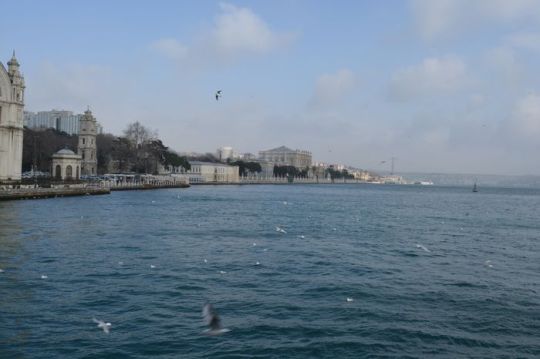
Stele of Nabonedes
ROOM RO. 12.—Potteries.
ROOM NO. 13.—Egyptian mummies and embroideries.
ROOM NO. 14.—The Irak of Arabia discoveries conducted by Americans. Stele of Nabonedes (No. 1327), King of Babylon, 555-538 B.C. The inscription on it refers to the destruction of Babylon by Sennacherib. In the various glass cases a rich and very instructive collection of tablets with cuneiform writings on them.
ROOM NO. 15.—Assyrian tablets with cuneiform writings.
In the middle in a Glass Case.—Alabaster statue of the Babylonian king Esa, 4000 years B.C.
ROOM NO. 16.—Babylonian tablets, vases, tiles, and scarabs.
Passage with glass cases on each side.
Vestibule—-Marble statues.
ROOM NO. 17.—Palmyrian and Himyaritic objects.
ROOM NO. 18.—Pottery ancl statues found in Cyprus, and belonging to the archaic art.
BRONZE AND JEWELS
ROOM NO. 19, OR ROOM OF BRONZE AND JEWELS. —Entering on the right : Hercules. On the left: Jupiter. Both are of bronze, and were found near Janina in Epirus. In Jupiter’s eyes are two granite stones, and they give him a wonderful expression. In front, No. 2 : The bronze bust of a young athlete. Glass case No. 114: Various bronze articles of the early Christian period. Glass case No. 121 : Various bronze small statues, and a plate representing Diana, and found at Pergamos. Glass case No. 115 : The Sidonian treasure, including the gold and jewels found in King Tabnith’s sarcophagus and others of massive gold, and two tablets of gold and one of silver. These latter are the only ones known up to now of these precious metals. Glass case No. 122: Bronze spears, scales and surgical instruments. Glass case No. 116: Bronzes from Lindos of Rhodes. Glass case No. 123 : Gold pieces from various tombs, also two crystal dice. Glass case No. 124 : Objects and a golden diadem found in tombs at Pergamos. Also an agate stone with a representation of Venus, of exquisite art.
Glass case No. 125 : Gold and bronze pieces found in Troy by Dr. Schliemann. The small sticks of massive gold were used as coins in the 12th cent. B.C. Glass case No. 117; Rings and chiselled stones. Glass case No. 128: The serpent’s head belonging to the Serpentine Column in the Hippodrome. A bronze wild boar found near Adrianople, and dating from the 5 th cent. B.c. Glass case No. 126 : Small bronze Egyptian statues. Glass case No. 118: Bronze vases and beads found in Ephesus during the excavations made by the British Museum. Large bronze Boman statue found in Tarsus. Glass case No. 119: The treasure of the old Temple of Ephesus discovered by the British Museum. Glass case No. 127: Bronze bracelets, candlesticks, etc., from Asia Minor. Glass case No. 120 : Bronzes from tombs in Thrace. Bronze statue No. 1 : An athlete.
0 notes
Text
astronomy lesson
Freya wakes up on the roof in the middle of the night. Tartar tells her about its new hobby.
924 words, no general warnings
It's the middle of the night when Freya's jolted awake. The cold night air is almost freezing on her skin as she blinks, feeling a drip of that bioluminescent blue ink fall out of her eyes.
"Shit," her mouth moves on its own as Freya scrambles to get a better hold on a tile. "I knew I should've- damn it. It's fine, go back to sleep, Freya."
"Tartar? What are we doing on the roof?" Freya asks, watching as the AI pilots their body to a safer spot. If she cranes her neck, she can spot a pile of haphazardly placed furniture on the ground floor stacked up to presumably let the AI climb up here in the first place.
"It's- shit." Freya watches as Tartar keeps its grip on a roof tile, adjusting to ensure they don't fall. "I must apologize. I should just go back insi-"
"Hey, you're not in trouble or anything. I promise." She can feel the tension in their body lessen slightly. "I'm just curious, that's all. If it's too personal, I can just go back to sleep."
Tartar doesn't respond, but adjusts itself to sit upright on the roof. "I am aware that your neighbors consider this behavior odd, but… I am stargazing."
"You are?"
"Affirmative." The AI quiets down as it lays down on the roof, watching the stars.
"Huh. I didn't realize you took an interest in that sort of thing, Tartar."
The AI huffs out a laugh at that. "It is a little preposterous for an information bank to have 'interests,' but I suppose it is one."
The two of them share a quiet moment as Freya's eyes scan the stars. She can tell the AI is tracing something out, but isn't sure of the shape.
"What are you looking for?" Freya asks at last.
"Orion's belt. From there, Orion the Hunter." Tartar traces out the line with a finger, well aware that Freya can follow along that way. "Follow the bow's path, and you'll find Taurus."
"Who's Orion?"
"A hunter from Greek mythology. I believe you would call him a pathetic excuse of a hunter, though. He was not very valorous." Tartar lets out a chuckle at that, refocusing its gaze on the stars. "That isn't the only interpretation of the constellation, though. There's a different version of who that figure is that varies from human culture to human culture. Some cultures believe Orion's Belt to be sacred animals, or figures of importance in their respective religions."
"That's interesting. And Taurus?"
"Taurus is from the Western Zodiac. It takes the shape of a bull and is associated with many ancient human cultures. Sumerian, Akkadian, Assyrian, Babylonian… you name it."
Freya quiets as Tartar continues to trace out constellation after constellation, the AI giving a brief explanation of the shape and culture that named it. The vigor in which Tartar talks about each set of stars paints a picture in Freya's heart that she cannot deny.
Tartar… misses humanity, doesn't it?
"Your turn," the AI huffs out, giving control over Freya's right arm back to her.
"My turn?" Oh, the constellations. Freya's eyes scan the stars, searching.
"They don't need to be human era constellations. I am just curious as to what your society makes of the star map." With that, Tartar gets comfortable on the roof, adjusting their left hand behind their head.
"There's the Rainmaker," Freya says, tracing the gun's shape with a faded barely green finger. "In its path is Baby Zapfish, then the Great Zapfish."
"Mhm?"
"And then south of the Great Zapfish are the three clans, the Eel, the Shark, and the Manta Ray." She couldn't tell if the AI was actually paying attention to her, but she kept going anyway. "Along the edge of the three clans is the Pinkfish, and the King Pinkfish… then further south, the primordial ancestors."
"And those are?"
"The Kraken and The Dofleini. Presumably the first of our kind to walk the earth."
Freya let her free hand rest on her stomach, watching the stars twinkle faintly. There were so many things she wanted to ask Tartar, but she felt the moment was fragile enough as is to disturb the peace. So for now, she was fine with being quiet, watching the night sky with the remnant of humanity's mechanical creation.
"Thank you, Freya. I have updated my information banks accordingly and added the constellations you shared with me under the Mollusc Era of star maps."
"Hey, don't mention it. I figured you wanted to know. Plus, you're a pretty good teacher."
"Hmm?"
Freya grins as she watches the sky, searching for Orion again. "I didn't think I'd be learning astronomy from you. This is nice. Thanks for the lesson, genuinely."
Tartar makes a quiet hum in response, the AI not finding much to say to that.
"Can I make a request though?"
"What would that be?"
"Next time you come up here, at least bring a jacket."
"...Yes, fair enough. I could do that."
"Awesome. Now, can you tell me more about one of those ancient human cultures?"
"Hah, eager to learn, aren't you? Very well."
She could feel herself starting to drift off halfway through the history of the Ancient Babylonians, but Freya could tell that the AI was smiling. Was this back and forth conversation fulfilling for it? Did it make Tartar feel better, even if only marginally?
Freya wasn't sure, but as she drifted off to sleep, the AI's hand laced together with Freya's.
"Good night, inkling."
"Good night, Tartar."
79 notes
·
View notes
Text
Babylon Rogues Theory Update: It’s a Fucking Birdemic Out There
OKAY SO A SIMPLE CONVERSATION ON THE SONIC DISCORD HAS TURNED INTO A PEPE SILVIA CONSPIRACY

[ID: The Pepe Silva meme, but the chaos map is covered with images from Sonic, such as Jet the Hawk, Longclaw the Owl opening a ring-portal, Space Colony ARK, Old Man Owl from the OVA, Shadow the Hedgehog, the Flickies in Sonic X, Extreme Gear Boots, and Shahra the Genie. End ID.]
WE’VE STUMBLED ONTO A FRANCHISE-WIDE CONSPIRACY INVOLVING FLICKIES, DIMENSION-HOPPING, AND SHADOW BEING PART BIRD. STRAP THE FUCK IN.
First of all, this conversation was spurned on by the assumption, which I proved yesterday, that the Babylon Rogues are from another dimension than regular Mobius and were powerful dimension-hoppers until crashing.
We began the conversation simply. With flickies.
@quartzquadrant mentioned their theory that the Babylonians were an attempt to reintroduce the flickies into the series as actual characters, as the flickies were originally conceptualized to be from another dimension, as revealed in Sonic 3D Blast.
But here’s the fun thing: what’s that exact reveal?

[ID: A photo of the flickies from Sonic 3D Blast, captioned: “Flickies are mysterious birds. They live in another dimension and can travel anywhere through large rings.” End ID.]
Now “another dimension” was just relating to the Babylonians-are-Dimension-Hoppers conspiracy, buT look at that last bit! THE FLICKIES CAN TRAVEL ANYWHERE THROUGH LARGE RINGS.
Such as............. in Sonic 2020?
But here’s the thing.... who was the first character (and ONLY, considering she had to give them to Sonic) who HAD these portal rings?
LONGCLAW. THE OWL. OWLS ARE BIRDS GUYS.

[ID: Longclaw the Owl from Sonic 2020, opening a portal to another planet with a magical ring. End ID.]
Longclaw ALSO shares a design with tiles found in both the movie and the original Sonic the Hedgehog game, linking her closely with the classic world the Flickies are associated with.

[ID: Photos from both Sonic 2020 and Sonic the Hedgehog (1991), in which an owl face very similar to Longclaw appears in the stones and tiles. End ID.]

[ID: A gif of Freckle from The Gay and Wondrous Life of Caleb Gallo, saying “What does it mean? What does it all mean?” End ID.]
But she’s not the only owl in the franchise! Aside from the comics, there’s a couple owls- a judge in Adventures of Sonic the Hedgehog, a mystical keeper of the time stones in SatAM (...interesting) and..... Old Man Owl from the Sonic OVA!

[ID: Old Man Owl from the Sonic OVA. He is wearing insanely 90s clothing and carrying a tubular skateboard. End ID.]
Old Man states early on in the film that he used to be a racer in his youth... a racer like the Babylon Rogues.

[ID: A promotional photo of the modern Babylon Rogues. Wave the Swallow is on the left, Jet the Hawk in the middle, and Storm the Albatross on the right. They are riding their Extreme Gear™ hoverboards in a race. End ID.]
We’ve come full circle, but this isn’t the end of the conspiracy linking all these birds together. No, no, the conversation continued quickly, and @zorloser mentioned that, in Sonic Riders, the Babylonians were referred to as genies, which is something i included in my dimension-hopping conspiracy. However, you know who else is linked to genies?
SHADOW THE HEDGEHOG.


[ID: Two screenshots from Sonic Adventure 2, of Shadow the Hedgehog. He has just been released from cryo, and says, “Since you were so kind to release me, my master... I will grant you one wish.” End ID.]
These are Shadow’s first lines in Dark Story of Sonic Adventure 2, his introductory game, and his lines reference the motifs of gaining wishes by freeing genies. Shadow’s main plotline in SA2, as well, was the desire to grant the wishes of others, firstly Gerald’s wish for destruction and then Maria’s for peace.
Know what Shadow also is, like the Babylon Rogues? An ALIEN! He has the dna of the Black Arms aliens!

[ID: Shadow standing beside his insanely tall demon dad, Black Doom, who is probably a tumblr sexyman in another dimension I’m glad I don’t live in. End ID.]
As he “dies,” he also appears like a shooting star, such as the Arks of the Cosmos.
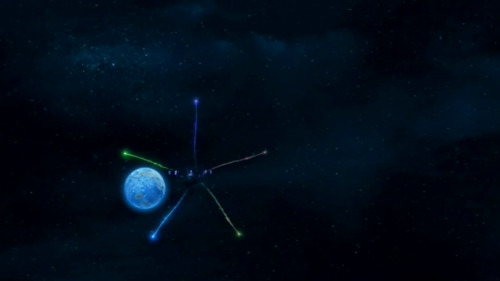
[ID: The Arks of the Cosmos falling from the Babylon Garden out in space, like shooting stars. End ID.]
ARKs. Like SPACE COLONY ARK. SHADOW’S HOME.

[ID: The Space Colony ARK, a floating satellite colony, as seen in the intro to Shadow the Hedgehog. It hovers above Earth with the sun behind it. End ID.]
But this all doesn’t stop there, oh no. No, no, because we realized, looking at Jet and Shadow’s designs, that they have way too many similarities.

As you can see, they have the same shape of chest fluff. Their gloves have those red-and-black squares and rings on the wrist. They have the same red, black and white colors on their shoes. They both have highlights on their quills/feathers in a similar shape, and they both have that red/black eyeshadow.
Both characters are also the leaders of their respective teams, as well as Sonic’s homoerotic rivals desperate to race him and prove they’re faster.

[ID: A gif from The Incredibles, of the teacher shouting, “Coincidence? I think NOT!” End ID.]
And it’s not just that... Shadow’s shoes are rocket boots that give him the ability to hover and glide. Know what else exists? EXTREME GEAR SHOES.

[ID: a comparison of the Extreme Gear™ shoes with Shadow’s weirdass shoes. End ID.]
Also, you know who else chose to take the form of Shadow the Hedgehog??? MEPHILES. Whose chest fluff not only looks vaguely bird-shaped, but if half of the god Solaris... a BIRD.

[ID: A closeup of Mephiles the Dark, who took the form of Shadow the hedgehog. His chest fluff resembles the silhouette a bird in flight. End ID.]

[ID: Solaris; its wings are spread like a bird and like Mephiles’s chest fluff. End ID.]
Birds are, somehow, everywhere in the Sonic franchise. They have been present from game one and keep being linked to symbols of power. And with the connection of the Babylon Rogues to Shadow, this can only mean one thing.
SHADOW IS PART BIRD.

[ID: A meme from Buzzfeed Unsolved. Shane, delusional, says “i’ve connected the two dots.” Ryan, just as delusional, responds “you didn’t connect shit,” to which Shane simply replies, “I’ve connected them.” End ID.]
thank you and goodnight.
#sonic the hedgehog#sonic riders#shadow the hedgehog#jet the hawk#babylon rogues#sonic 2020#sonic ova#sonic 3d blast#sonic theory#connie theories#mine
466 notes
·
View notes
Text
S5 Ep 15 Pt 2: Don’t Trust Anyone Who Wears a Floor Length Robe Over Their Casuals in Yugioh
Hey, it’s my birthday, so I’m gonna release this early because the rest of today I just have to work like an adult and that’s no fun.
In the first half of this episode we dunked the worlds smallest plane into a lake and so this second half of the episode involved the kids running as far away from their only responsible adults as they could.
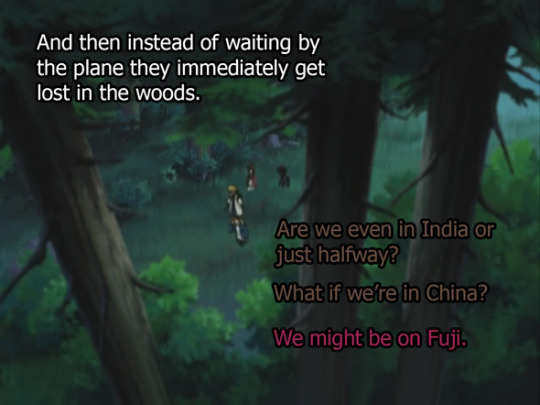
Which like...took whole of less than a second for them to peace out and enter mortal danger.
...I’ve never been in a jungle in India but...I have seen the Jungle book many times...and there’s like tigers and stuff in there, right? and tons of monkeys that are hella mean? And freakin snakes? They sing jazz and scat? That’s some terrifying stuff.
Like these city kids have to learn at some point to fear the woods. But they just freakin don’t. And strangely, the most dangerous thing in these woods isn’t even a snake or something, but a human man just being as suspicious as possible lying prone on the ground.
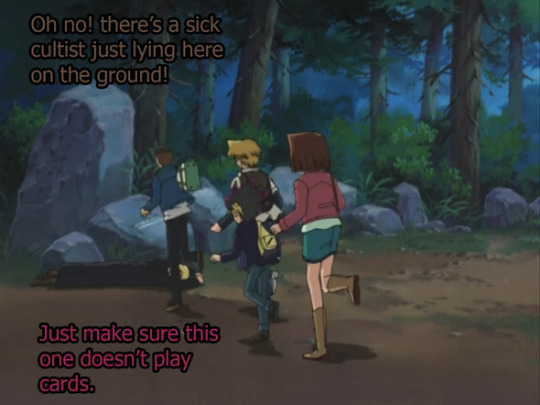

(read more under the cut)
The card cultist happens to have a British accent, because this voice acting team freakin loves to pull out their British accents. It’s not as lowbrow as Valon, but it’s not as...well whatever Bakura is supposed to be. He’s a lot more tame than Bakura’s, but still very British.
I don’t know if this is because British English tends to be taught instead of American sounding English in many parts of India, but, most likely they just wanted to do an accent. And like...he’s an archeologist...and so the stereotype is there...but honestly, the decision of making this guy British gets weirder and weirder as this episode goes on, get ready for it. None of you are ready for what I assume is the very obvious plot twist of this freakin guy.
Catfish of the century, this freakin guy, I’m pretty sure.

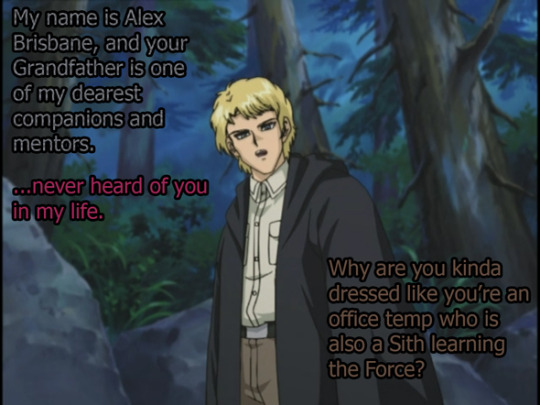
Yugi immediately believes this completely out of place white British stranger in the Indian backwoods next to this inaccessible lake and immediately thinks “yes, my Grandfather crash landed in India EXACTLY where I’m standing right now, and now I must save him.”
Thankfully, Yami exists to gently and politely tell Yugi to hella stop.

Also, I like that Yugi has finally stopped wearing his school outfit out of school. But, he is instead wearing a jacket that is so close to his school outfit I honestly couldn’t tell until the end of this episode. It’s like...I think one shade more purple, it has white piping, and his undershirt has a center seam. It’s nice Yugi has 3 versions of the same black sleeveless undershirt, and this show cares enough to show that tiny factoid about Yugi’s closet.
So, because Yugi is a dumbass and Pharaoh has to just sit back and watch this happen so he can say “told you so” later, they follow this random cultist they found in the woods. Much like Hansel and Gretel, we snack on cake crumbs all the way to the witches house, which in this case, is an undiscovered monolith you would have easily seen from outer space.

HMMMMMMMMMM.

And so get ready for this:

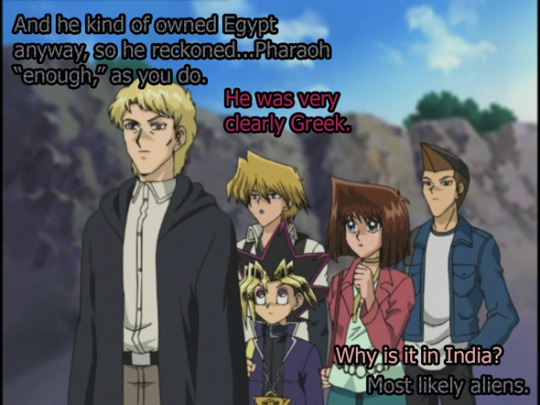
Hey guys.
Remember how Alexander the great was buried in a pyramid?
Now because they’re name dropping Alexander, that’s actually kind of helpful, because Alexander the Great’s favorite damn horse in the entire world died while he was at war with India so he named a city after it. It’s believed to be in Punjab, which is in the Northern part of India
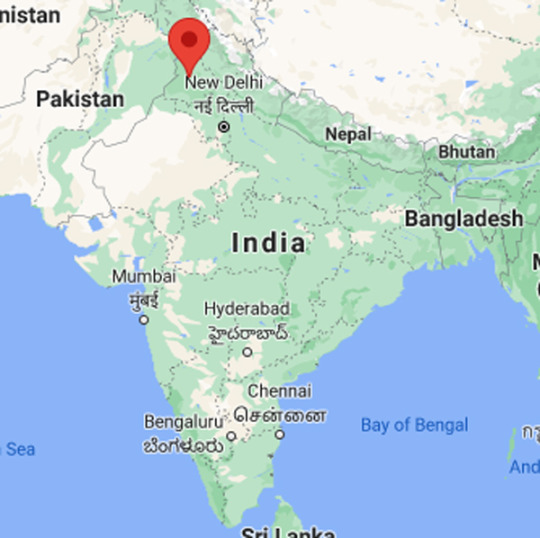
Which means we first of all, definitely crossed the tallest mountain range in the world to get here, and also means that we are like...in some really disputed territory of India right now, and it is crazy that these kids went here for a vacation completely unsupervised.
Another fun fact about Alexander is that when he died, it took 6 days for his body to decompose. At the time, they thought it was because he was a God (or in Yugioh’s case, Extremely Cursed) but nowadays historians think it’s because it took him 6 days to fully die. He just wasn’t dead yet. Had to give it a minute and the ancient Babylonians just got way too excited.
Anyway, Alexander super died in Babylon so I don’t know what the hell he’s doing in India. There is a fun spot in History where his body did get dragged to a couple different places, meaning we probably did lose the original Alexander and there’s a lot of people just guessing at where he ended up...but putting him clear up in India sure was a choice when one of his assumed burial sites was literally Egypt, which would be a more fitting location for a Pyramid and a more fitting location for this show.
Especially since Alexander was trying to invent a new race and culture...it seems a little strange he’d be buried in such a massive pyramid, but maybe he got a really, really good pyramid deal from the funeral home when he was like 28 and just figured he’d change it before the time he died at 32.
Which...now that I’m older than 32, how crazy is it that Alexander the Great died at freakin 32? You blink twice and you’re 32. Is history seriously trying to tell me this guy wasn’t like secretly 62? That maybe he just celebrated his 20th for like 20 years in a row as a royal mandate? I just feel like history is playing pranks on me with Alexander.
Anyway, our weird shady new archeologist guy is named Alex and so take that as you will.

I sure hope Alexander the Great was revived to wear khakis and bother children. Guy conquered the world once and was one of history’s Freakin Worst so he does deserve it, but also...it would explain why he thinks it’s normal to wear a Darth Maul robe over your business casual.
Anyway, lets enter the obvious trap pyramid.
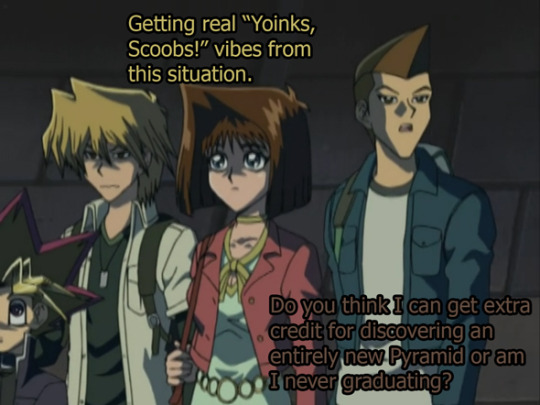
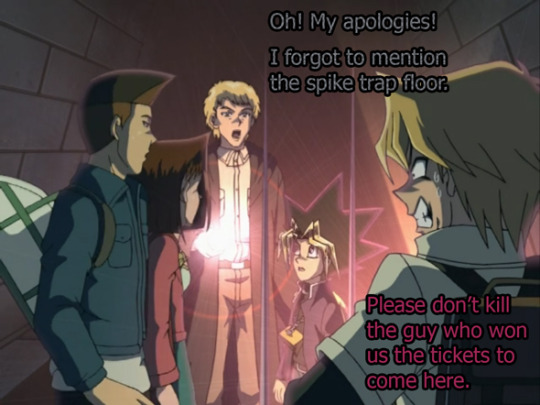
Joey just wanted a nice time running around Northern India. He just wanted to eat some yummy chaat and look at some tourist destinations and maybe glance at a Bollywood star or two. But instead he’s gotta deal with spike floors because Yugi couldn’t say no to a cultist.
Also...one of those spikes clearly went through Tea’s feet, right? And she is absolutely fine? Just checking on Tea’s godlike strength and clearly it is still godlike.
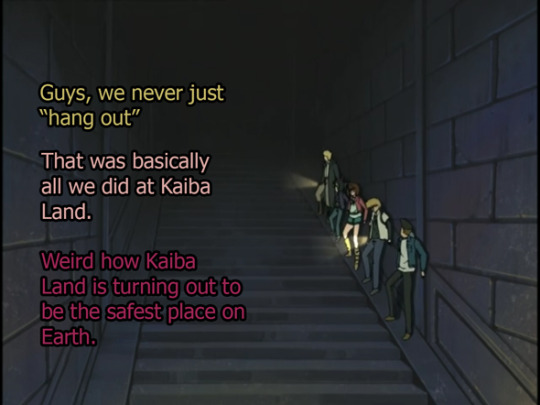

Alex gives us a very long explanation of how he went upstairs and Grandpa went downstairs, and there was a door or something so Alex turned back around and Grandpa was gone.
All of those steps were probably plot relevant and I’ll probably forget all about it in 2 episodes.

The thing is Alex...literally thinks he evaporated. Literally thinks that. But how do you disprove it to this freakin guy who like...might have named a city after his horse once and thinks that’s a normal and acceptable thing to do?

and so Joey immediately leaps onto the haunted playing floor.
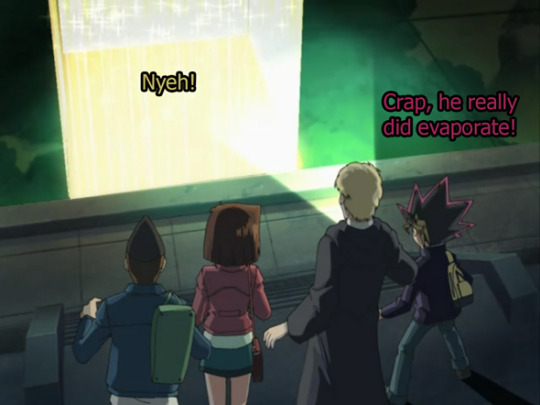
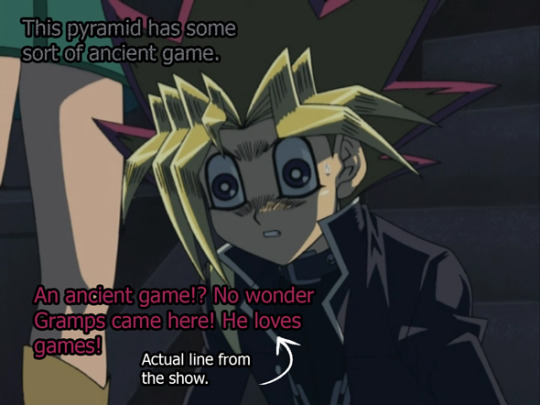
the way Yugi said this line was sort of hilarious to me so I may cap it. If I remember to do it (I’ve been a little busier lately, with things opening up, as you can tell because my update schedule is in the toilet.)
So, if Joey jumps in...everyone else has to, also.
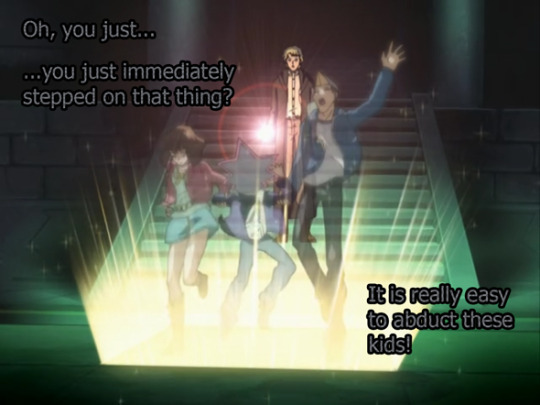
And we say good bye to Alex and enter the new forest zone, which looks a LOT like the other forest we were just in.
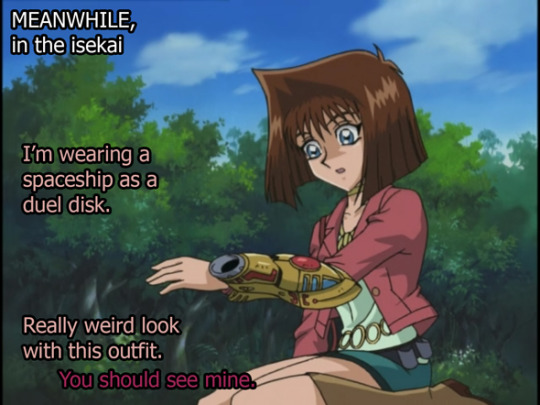
Nice Protoss armor.
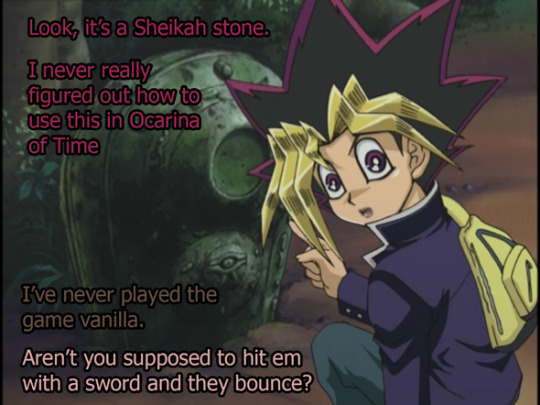
We get some hijinks from the local wildlife, which are all cards but real (but not real because we’re in a board game...don’t think about it) and the off brand Sheikah tablets have helpful monsters in them if you touch em.
This season may have been better off as a video game, being honest.

Joey has gone somewhere else, despite going onto the same game tile, and he’s too busy on a mountain range to really help anyone out. So he’s just gonna vibe up here for a bit.
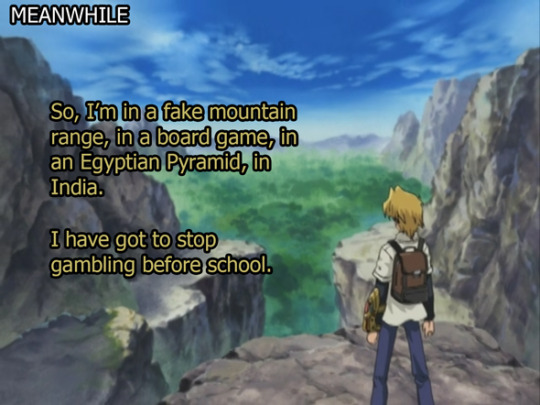
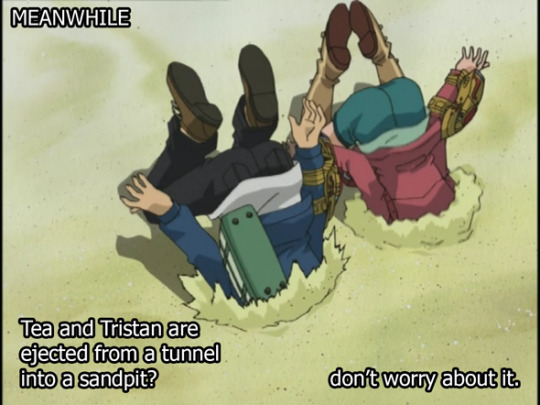
Tea got up after this point and said along the lines of “k, what’s next?” Because mortal danger does not affect her and she fears nothing.
At a beach somewhere, Tea and Tristan spend some quality time together forming a new family with whatever these creatures are.

And Tea’s love of her winged angel comes full circle and now I will suffer this winged orb for the rest of this arc, pretty sure.
Please admire the number of belts on Tea. Her outfit is like max 00′s and I appreciate that. We’ve had a lot of questionable fashion on Yugioh, but they actually dressed Tea pretty on point this arc. Like I often feel like 00′s fashion is hard to define or describe, but it’s Tea right now. That’s it. She did it, it’s right there.

Yugi gets a new flagship card for this arc, and this time it’s Celtic Guardian. Hell why? I feel like his defining card changes every single arc, and they need to like focus and just give him one. In fact, I’m pretty sure it’s still Dark Magician...and maybe the show forgot?
Anyway, if you just got here, this is a link to read the rest:
https://steve0discusses.tumblr.com/tagged/yugioh/chrono
I think I forgot that link in the last recap because yo it’s kind of been a while since I’ve updated, I feel. (well I had a graveyard post and those don’t count really) But, we’re back, we’re still going, slowly but surely.
#YGO#yugioh#Yu gi oh#episode recap#photo recap#S5#Ep16#yugi muto#yami#capsule monsters#tea gardner#tristan taylor#Joey Wheeler#Alex Brisbane#Alexander the freakin great#and a pyramid in the middle of Northern India#And lets just make it an isekai for kicks
35 notes
·
View notes
Photo

Decorated in a glorious lapis lazuli glazed brick fortifying the ancient city walls, the Ishtar gate is a monumental wonder forever inspiring our atelier. Constructed by the Babylonian King Nebuchadnezzar II circa 575 BCE, it was the eighth gate of the city of Babylon an was the main entrance into the city of antiquity. The gate is adorned with glazed bricks with alternating rows of dragons and bulls; furnished in amber yellow and earthy brown tiles, while the bricks surrounding them are in a deep luxurious blue. Through the gatehouse is the Processional Way, which is a brick-paved corridor adorned with over 120 sculptural lions, flowers, and enamelled yellow tiles over one kilometre long with walls over 15m tall on each side. A source of inspiration for our recent bespoke Babylonian ring and soon to be an ode for our upcoming El Arabiyyah Collection | Iraq Edition. https://www.instagram.com/p/CczV2KoBXtW/?igshid=NGJjMDIxMWI=
2 notes
·
View notes